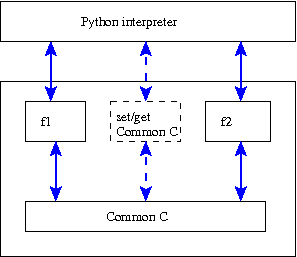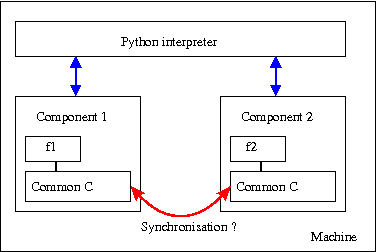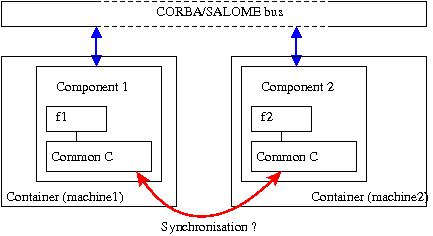Appendix: processing of fortran commons and C / C++ global variables¶
Fortran common¶
This section is the result of studies carried out by Marc Boucker, Alexandre Douce, Céline Béchaud and Marc Tajchman (for further details, see [COMMON]). We do not aim to present a complete state of possible situations in this description. The fortran 77 codes that are to be controlled from the python interpreter or from Corba / SALOME often define memory zones shared between the different fortran functions, called “common”. For example, functions f1 and f2 use the same memory zone a in common C.
f1.f
real function f1(x)
real x
C
real a
common / C / a
C
f1 = x / a
return
end
f2.f
real function f2(x)
real x
C
real a
common / C / a
C
f2 = x * a
return
end
If the two functions are contained in the same component and common C is not used by functions of other components, the common is not visible from outside the component and “everything takes place properly” (see figure Using a common in a component). If the component designer wants to allow common to be read or written from the python and/or CORBA layer, he will easily be able to write access functions (for example setCommon and getCommon functions in the following example).
common.f
subroutine setcom(b)
real b
C
real a
common / C / a
C
a = b
C
return
end
subroutine getcom(b)
real b
C
real a
common / C / a
C
b = a
C
return
end

Using a common in a component
The following is an example encapsulation in C++, then in python (through swig):
f.hxx
extern "C" float f1(float *);
extern "C" float f2(float *);
extern "C" void setcom(float *);
extern "C" void getcom(float *);
class f {
public:
f() {
float y = 1.0;
setcom(&y);
}
void setCommon(float x) {
setcom(&x);
}
float getCommon() {
float x;
getcom(&x);
return x;
}
float f1(float x) {
return ::f1(&x);
}
float f2(float x) {
return ::f2(&x);
}
};
modf.i
%module modf
%{
#include "f.hxx"
%}
class f {
public:
void setCommon(float x);
float getCommon();
float f1(float x);
float f2(float x);
};
A practical example:
>>> import modf
>>> f = modf.f();
>>> f.init(3.0)
>>> print f.f1(1)
0.333333343267
>>> print f.f2(1)
3.0
>>> print f.f1(f.f2(1))
1.0
If common C is used in several dynamic libraries, management is more difficult. In general, it is impossible to assume that the common used by each library is located at the same memory address. There are two typical situations that can arise:
The two components are installed locally from the same python interpreter:

Using a common shared between two libraries – Local version
The two components are installed in different memory zones (on the same machine or on different machines) through the SALOME mechanism (containers):

Using a common shared between two libraries – distributed version
Synchronization functions are necessary in both cases (for example using functions to read / write commons from the python and/or SALOME command layer). The adaptation to the case of two local components loaded from a python interpreter is written as follows:
For the first component:
f1.hxx
extern "C" float f1(float *); extern "C" void setcom(float *); extern "C" void getcom(float *); class f { public: f() { float y = 1.0; setcom(&y); } void setCommon(float x) { setcom(&x); } float getCommon() { float x; getcom(&x); return x; } float f1(float x) { return ::f1(&x); } };modf1.i
%module modf1 %{ #include "f1.hxx" %} class f { public: f(); float f1(float x); void setCommon(float x); float getCommon(); };For the second component:
f2.hxx
extern "C" float f2(float *); extern "C" void setcom(float *); extern "C" void getcom(float *); class f { public: f() { float y = 1.0; setcom(&y); } void setCommon(float x) { setcom(&x); } float getCommon() { float x; getcom(&x); return x; } float f2(float x) { return ::f2(&x); } };modf2.i
%module modf2 %{ #include "f2.hxx" %} class f { public: f(); float f2(float x); void setCommon(float x); float getCommon(); };Read and write functions for the common will be included in each component.
A practical example
>>> import modf1
>>> import modf2
>>> f1 = modf1.f();
>>> f2 = modf2.f();
>>> f1.setCommon(2.0)
>>> print "f1(1) = ", f1.f1(1.0)
f1(1) = 0.5
>>> print "avant synchronisation"
avant synchronisation
>>> print "f2(1) = ", f2.f2(1.0)
f2(1) = 1.0
>>> f2.setCommon(f1.getCommon())
>>> print "après synchronisation"
après synchronisation
>>> print "f2(1) = ", f2.f2(1.0)
f2(1) = 2.0
In summary, if an existing code comprising commons has to be broken down into several components, it is possible to either:
- modify the code by removing the commons and transferring information through lists of function parameters;
- write functions to provide read/write access to the commons and use these read/write functions from layers higher than components, so as to synchronize the internal states of the different components.
The first solution requires that in-depth action is taken in the fortran code, while the second requires that the user explicitely synchronises commons in the different components. It is strongly recommended that commons should not be used in new fortran codes.
C/C++ global variables¶
The situation is similar to the case of commons: each component will have its own set of global variables. A method is necessary to assure that these different sets of variables are consistant.